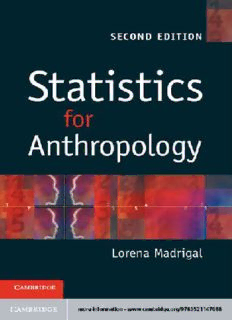
Statistics for Anthropology PDF
Preview Statistics for Anthropology
StatisticsforAnthropology SecondEdition Anthropologyasadisciplineisrapidlybecomingmorequantitative,andanthropology studentsarenowrequiredtodevelopsophisticatedstatisticalskills.Thisbookprovides studentsofanthropologywithaclear,step-by-stepguidetounivariatestatisticalmethods, demystifyingtheaspectsthatareoftenseenasdifficultorimpenetrable. Explaining the central role of statistical methods in anthropology, and using only anthropological examples, the book provides a solid footing in statistical techniques. Beginningwithbasicdescriptivestatistics,thisneweditionalsocoversmoreadvanced methodssuchasanalysesoffrequenciesandvariance,andsimpleandmultipleregres- sionanalysiswithdummyandcontinuousvariables.Itaddressescommonlyencountered problemssuchassmallsamplesandnon-normality.Eachstatisticaltechniqueisaccom- paniedbyclearlyworkedexamples,andthechaptersendwithpracticeproblemsets. Manyofthedatasetsareavailablefordownloadatwww.cambridge.org/ 9780521147088. LorenaMadrigalisProfessorofAnthropologyattheUniversityofSouthFlorida,Tampa. A biological anthropologist, she is particularly interested in the evolution of Afro and IndoCostaRicanpopulationsresidingintheAtlanticcoastofCostaRica.Sheiscurrently PresidentoftheAmericanAssociationofPhysicalAnthropologists.ShelivesinTampa withhertwodaughters. Statistics for Anthropology Second Edition LORENA MADRIGAL UniversityofSouthFlorida,USA CAMBRIDGEUNIVERSITYPRESS Cambridge,NewYork,Melbourne,Madrid,CapeTown, Singapore,Sa˜oPaulo,Delhi,MexicoCity CambridgeUniversityPress TheEdinburghBuilding,CambridgeCB28RU,UK PublishedintheUnitedStatesofAmericabyCambridgeUniversityPress,NewYork www.cambridge.org Informationonthistitle:www.cambridge.org/9780521147088 (cid:2)C L.Madrigal1998,2012 Thispublicationisincopyright.Subjecttostatutoryexception andtotheprovisionsofrelevantcollectivelicensingagreements, noreproductionofanypartmaytakeplacewithoutthewritten permissionofCambridgeUniversityPress. Firstpublished1998 Secondedition2012 PrintedintheUnitedKingdomattheUniversityPress,Cambridge AcataloguerecordforthispublicationisavailablefromtheBritishLibrary LibraryofCongressCataloguinginPublicationdata Madrigal,Lorena. Statisticsforanthropology/LorenaMadrigal.–Secondedition. pages cm Includesbibliographicalreferencesandindex. ISBN978-0-521-14708-8 1.Anthropology–Statisticalmethods. I.Title. GN34.3.S7M33 2012 301.072(cid:3)7–dc23 2011044367 ISBN978-0-521-14708-8Paperback Additionalresourcesforthispublicationat www.cambridge.org/9780521147088 CambridgeUniversityPresshasnoresponsibilityforthepersistenceor accuracyofURLsforexternalorthird-partyinternetwebsitesreferredto inthispublication,anddoesnotguaranteethatanycontentonsuch websitesis,orwillremain,accurateorappropriate. Thisbookisdedicatedtoallparentswhoneverquestionedtheirchildren’s decisiontopursueacareerinanthropology.Topartnerswhoofferedsupport andcomfort.Andtochildrenwhohelpedusgrowtothelimit.Mayallpeoplebe asluckyasIhavebeen. Contents Listofpartialstatisticaltables pagexi Preface xiii 1 Introductiontostatisticsandsimpledescriptivestatistics 1 1.1 Statisticsandscientificenquiry 1 1.2 Basicdefinitions 3 1.2.1 Variablesandconstants 3 1.2.2 Scalesofmeasurement 4 1.2.3 Accuracyandprecision 6 1.2.4 Independentanddependentvariables 6 1.2.5 Controlandexperimentalgroups 7 1.2.6 Samplesandstatistics,populationsandparameters.Descriptive andinferentialstatistics.Afewwordsaboutsampling 8 1.3 Statisticalnotation 9 1.4 Chapter1keyconcepts 12 1.5 Chapter1exercises 12 2 Thefirststepindataanalysis:summarizinganddisplayingdata.Computing descriptivestatistics 13 2.1 Frequencydistributions 13 2.1.1 Frequencydistributionsofdiscontinuousnumericand qualitativevariables 13 2.1.2 Frequencydistributionsofcontinuousnumericvariables 15 2.1.3 Stem-and-leafdisplaysofdata 17 2.2 Graphingdata 18 2.2.1 Bargraphsandpiecharts 19 2.2.2 Histograms 21 2.2.3 Polygons 21 2.2.4 Boxplots 21 2.3 Descriptivestatistics.Measuresofcentraltendencyanddispersion 25 2.3.1 Measuresofcentraltendency 26 2.3.2 Measuresofvariation 29 2.4 Chapter2keyconcepts 39 viii Contents 2.5 Computerresources 40 2.6 Chapter2exercises 40 3 Probabilityandstatistics 42 3.1 Randomsamplingandprobabilitydistributions 43 3.2 Theprobabilitydistributionofqualitativeanddiscontinuous numericvariables 44 3.3 Thebinomialdistribution 46 3.4 ThePoissondistribution 48 3.5 Bayes’theorem 53 3.6 Theprobabilitydistributionofcontinuousvariables 57 3.6.1 zscoresandthestandardnormaldistribution(SND) 63 3.6.2 Percentileranksandpercentiles 71 3.6.3 Theprobabilitydistributionofsamplemeans 73 3.6.4 Ismybellshapenormal? 77 3.7 Chapter3keyconcepts 78 3.8 Computerresources 79 3.9 Chapter3exercises 80 4 Hypothesistestingandestimation 83 4.1 Differentapproachestohypothesistestingandestimation 83 4.1.1 Theclassicalsignificancetestingapproach 83 4.1.2 Themaximumlikelihoodapproach 84 4.1.3 TheBayesianapproach 84 4.2 Estimation 84 4.2.1 Confidencelimitsandconfidenceinterval 85 4.2.2 Pointestimation 89 4.3 Hypothesistesting 90 4.3.1 Theprinciplesofhypothesistesting 90 4.3.2 Errorsandpowerinhypothesistesting 93 4.3.3 Hypothesistestsusingzscores 98 4.3.4 One-andtwo-tailedhypothesistests 100 4.3.5 Assumptionsofstatisticaltests 101 4.3.6 Hypothesistestingwiththetdistribution 103 4.3.7 Hypothesistestsusingtscores 104 4.3.8 Reportinghypothesistests 105 4.3.9 Theclassicalsignificancetestingapproach.Aconclusion 106 4.4 Chapter4keyconcepts 106 4.5 Chapter4exercises 107 5 Thedifferencebetweentwomeans 108 5.1 Theun-pairedttest 108 5.1.1 Assumptionsoftheun-pairedttest 112
Description: